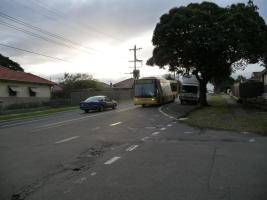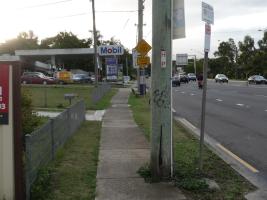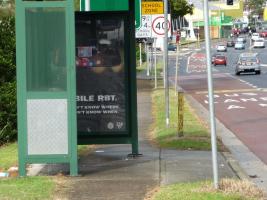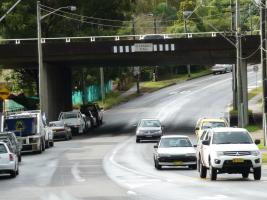Bike North & CAMWEST discuss M2 with RTA & Transurban
The original PDF document (881 Kbytes) written by John, from which this text and photos come. This
Environmental Assessment
On 26 May 2010, members of cycling interest groups including Bike North and CAMWEST met with the M2 and RTA Personnel for an information session regarding the Environmental Assessment for the proposed M2 widening project and also an update on the proposed alternative cycle route to be used during the 2 year update project.
A presentation consisting of about 12 Power point Slides summarised a very large Environmental Impact Study of 3 Volumes, each consisting of many hundreds of pages.
Some issues were explored by the meeting, but it was obvious
that neither the presenters or participants had anything more
than a basic knowledge of the documents. When questioned on
the common name for a threatened species of
plant,
Proposed Cycle Detour
Following that presentation, a further session provided information on the proposed cycle detour.
The group was informed that an independent audit of the proposed route had been carried out by Terry Winning, of Winning Traffic Solutions Pty Ltd. Mr Winning had “driven and walked” the entire route and had made a video of the route. The video was not available for perusal, nor was Mr Winning present to answer any questions pertaining to his audit. This is in conflict with a previous agreement — As set out in this document, which is reproduced in full later in this document. (Appendix 1)
Safety Audit
Response by Transurban to questions asked by Bike North about the M2 widening project (PDF 120 Kbytes)
“Details about the safety audit will be provided to the Cyclists Working Group as part of the summary of the detailed design. The auditor would be available to answer any questions the Cyclists Working Group may have about the audit process.”
When queried if Mr Winning had ridden the route to gain a cyclist perspective a comment was made from one presenter: “I wouldn’t trust Terry on a bike”.
During the presentation, it became obvious that very little had been done since the last information meeting. Numerous issues that had been raised previously had been ignored and were still included in this document. It appears the project is being run backwards. The Traffic Planners are making decisions regarding the proposed alternate route without adequate consultation with cycling groups, who, although they may not have ‘expert’ qualifications, do have on the ground, detailed experience and knowledge of this route and had input from them been taken on board when initially presented, many issues could have been resolved before reaching this stage of the project.
A summary of the route was presented from West to East beginning with the intersection of Old Windsor Road and Hammers Road.
At this point, the cycle route leaves the existing Old Windsor Road Transit Way Cycle Path. Cyclists travelling east are expected to cross the T-Way, Old Windsor Road and a left hand turn lane on Hammers Road, before riding onto a shared path for a short distance and then rejoining motorised traffic in Hammers Road.
No mention was made of any strategy for crossing Toongabbie Creek on Hammers Road. At this point the road is a single lane each way with a steep downhill approach on each side which equates to a steep climb on the other. Cyclists should be able to travel fast enough on the downhill run to almost match traffic speeds. I would suggest a cycle lane for cyclists on the uphill sections.

A similar lack of attention was paid to traffic entering Kleins Road from Hammers Rd. Cyclists will be expected to negotiate a single lane roundabout. When travelling East this will require a right hand turn at this roundabout to travel South in Kleins Road before turning left to travel east again in Northmead Ave. Similarly, traffic travelling West will need to negotiate the intersection of Kleins Rd and Northmead Ave before travelling with traffic on road to Hammers Road and turning left.

Northmead Ave is the preferred alternative route for the developers which will lead to Windsor Road where riders will travel for a short distance along Windsor Road before negotiating the traffic control signals at this intersection as a pedestrian to travel across Windsor Road.
Picture shows current alignment of Windsor Road between James Ruse Drive and Northmead Ave.
Once across Windsor Road, cyclists will then negotiate two turning lanes of traffic before travelling down the footpath to North Rocks Road. Transurban propose to widen this footpath to 3 metres and have a two way shared path along this section before cyclists turn into North Rocks Road.

Current view of Church St, Nth Parramatta leading to North Rocks Road.
Presently there are 26 poles planted in this section of footpath as well as the bus stop, several electrical control boxes and access to major cabling and other utilities. The path is 3 metres wide in most places.

Travelling east in North Rocks Road will require travelling along a footpath section to Bunnings Driveway, then entering traffic to travel up North Rocks Rd. The present proposal for West bound traffic is to utilise a shared path on the southern side of North Rocks Road before negotiating the pedestrian crossing back to the Northern side of the road to use the shared path up Church St.
APPENDIX 1
This refers to the response from Transurban above,
The detailed design for the alternative cycle route is being undertaken by highly experienced And specialist transport consultants, GTA, in conjunction with the Project Team and RTA. Once the design process is complete, it will be subject to a review by the RTA and an independent external safety audit will be undertaken.
Following the safety audit, the final design would be presented to the Cyclist Working Group and local councils. As a part of this process, all parties would be invited to provide feedback from an ‘end-user’ point of view so any required minor on-the-ground modifications could be made where appropriate.
The route would then be constructed by LCPL. This would be subject, however, to the overall proposed M2 Upgrade receiving all of the necessary statutory approvals from the NSW Department of Planning and any specific ‘approval conditions’ that the Director- General of Planning may impose on the project.
4. Design for cyclists (points a–f) The design and construction of the alternative cycle route will be undertaken in accordance with the RTA’s Bicycle Guidelines where feasible and reasonable. If during the detailed design phase, it is found that a section of the preferred route is not feasible, alternative route options would be further investigated for that section.
As the alternative cycle route requires specialised expertise and design skills, transport consultant GTA have been engaged to work with the Project Team and RTA to produce the concept and detailed designs. There will be an opportunity for cyclists’ interest groups to provide feedback on the final detailed design from an end-users perspective. Details about the safety audit will be provided to the Cyclists Working Group as part of the summary of the detailed design. The auditor would be available to answer any questions the Cyclists Working Group may have about the audit process. The alternative cycle route will be designed to meet the project’s specific timeframe and cost constraints. It will also need to meet all of the relevant standards and appropriate RTA / local council requirements.
All appropriate signalling, signage and logos used along the alternative cycle route will be designed and constructed in line with RTA requirements. This includes signage at existing single lane roundabouts and installation of bike lanterns on existing pedestrian crossings (including their sequencing). Local council requirements would also be considered. As part of the overall process to identify the preferred alternative cycle route, analysis of existing single lane roundabouts was undertaken by GTA. This included GTA personnel cycling the preferred route. Where possible, every effort has been made to avoid single lane roundabouts.
